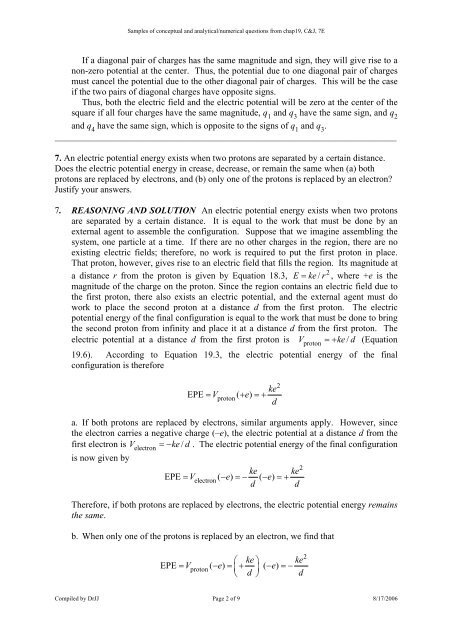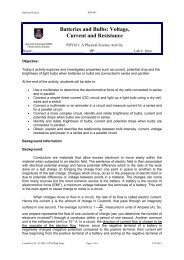Basic Physics II Evidences - DrJJ - UiTM
Basic Physics II Evidences - DrJJ - UiTM
Basic Physics II Evidences - DrJJ - UiTM
Create successful ePaper yourself
Turn your PDF publications into a flip-book with our unique Google optimized e-Paper software.
Samples of conceptual and analytical/numerical questions from chap19, C&J, 7EIf a diagonal pair of charges has the same magnitude and sign, they will give rise to anon-zero potential at the center. Thus, the potential due to one diagonal pair of chargesmust cancel the potential due to the other diagonal pair of charges. This will be the caseif the two pairs of diagonal charges have opposite signs.Thus, both the electric field and the electric potential will be zero at the center of thesquare if all four charges have the same magnitude, q 1and q 3have the same sign, and q 2and q 4have the same sign, which is opposite to the signs of q 1and q 3.__________________________________________________________________________________________7. An electric potential energy exists when two protons are separated by a certain distance.Does the electric potential energy in crease, decrease, or remain the same when (a) bothprotons are replaced by electrons, and (b) only one of the protons is replaced by an electron?Justify your answers.7. REASONING AND SOLUTION An electric potential energy exists when two protonsare separated by a certain distance. It is equal to the work that must be done by anexternal agent to assemble the configuration. Suppose that we imagine assembling thesystem, one particle at a time. If there are no other charges in the region, there are noexisting electric fields; therefore, no work is required to put the first proton in place.That proton, however, gives rise to an electric field that fills the region. Its magnitude at2a distance r from the proton is given by Equation 18.3, E = ke / r , where +e is themagnitude of the charge on the proton. Since the region contains an electric field due tothe first proton, there also exists an electric potential, and the external agent must dowork to place the second proton at a distance d from the first proton. The electricpotential energy of the final configuration is equal to the work that must be done to bringthe second proton from infinity and place it at a distance d from the first proton. Theelectric potential at a distance d from the first proton is Vproton =+ ke/d (Equation19.6). According to Equation 19.3, the electric potential energy of the finalconfiguration is thereforekeEPE = Vproton( + e)=+da. If both protons are replaced by electrons, similar arguments apply. However, sincethe electron carries a negative charge (–e), the electric potential at a distance d from thefirst electron is Velectron =− ke/d . The electric potential energy of the final configurationis now given by2EPEelectron( ) ke ke= V − e =− ( − e)=+d dTherefore, if both protons are replaced by electrons, the electric potential energy remainsthe same.b. When only one of the protons is replaced by an electron, we find that2⎛EPEproton( ) ke ⎞ ke= V − e = ⎜+ ⎟ ( − e)=−⎝ d ⎠ d2Compiled by <strong>DrJJ</strong> Page 2 of 9 8/17/2006
















